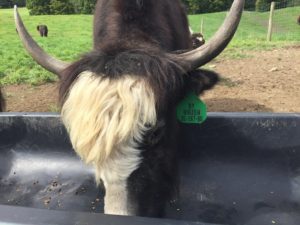Last month, a local county agricultural council sponsored their annual farm fest, where a number of local farms are open on a weekend day for free tours / open house. It just so happens that one of the farms open for tours was only ~3 miles away so we decided to stop by.
Although only a few miles away, the farm isn’t directly visible from the road, so we had no idea that they raise… yaks!
Here is a picture of one of their yaks:
We learned that yaks are a triple threat – they are raised for milk, meat and fiber. The farm was selling yak sliders and yak yarn and fiber products during the open house.
According to the farmer, yaks are smaller than typical beef and dairy cows – the adult females are typically only 500 to 600 pounds. Adult male yaks (domesticated) can weigh in at 900 – 1,200 pounds. For reference, typical beef cattle bulls can reach closer to 2,000-3,000 pounds (but are often slaughtered younger so are usually seen at lower than full weight).
Here is a close-up shot so you can see their shaggy fur coat. Their fiber is used to make yarn and then into whatever product from there. The farm was selling knit yak products such as winter hats.
Yaks come in a variety of color patterns. A black yak is called an imperial yak. A yak that is white and black is called a royal yak. There are also somewhat rare golden yaks that are all light brownish in color.
Their herd had some young yaks as well. Here is a picture of some younger yaks at the feeding trough.

Alpacas in the pasture.
In addition to the yaks, that same farm also raised alpacas. They raised the alpacas for fiber.
After the yak farm, we also took a tour of an organic dairy farm.
They had a robotic milking machine – the cows were basically free range around the open pasture and open barn and could decide on their own when they wanted to be milked. The cows were wearing collars with rfid tags so the robot can track which cows were milked when and how much milk they produced. The software tracking the cows alerts the farmer if a certain cow hasn’t been milked in too long.
The cows enter the milking stall on their own and then the robot conducts the entire milking process without any human intervention. It detects and cleans their udders and then milks the cow and sends the milk to the holding tank. Unfortunately I forgot to get any pictures or videos, but it was quite interesting to watch and I recommend that you go to see one in action if you ever get the chance.





I like the sweaters on those alpacas!